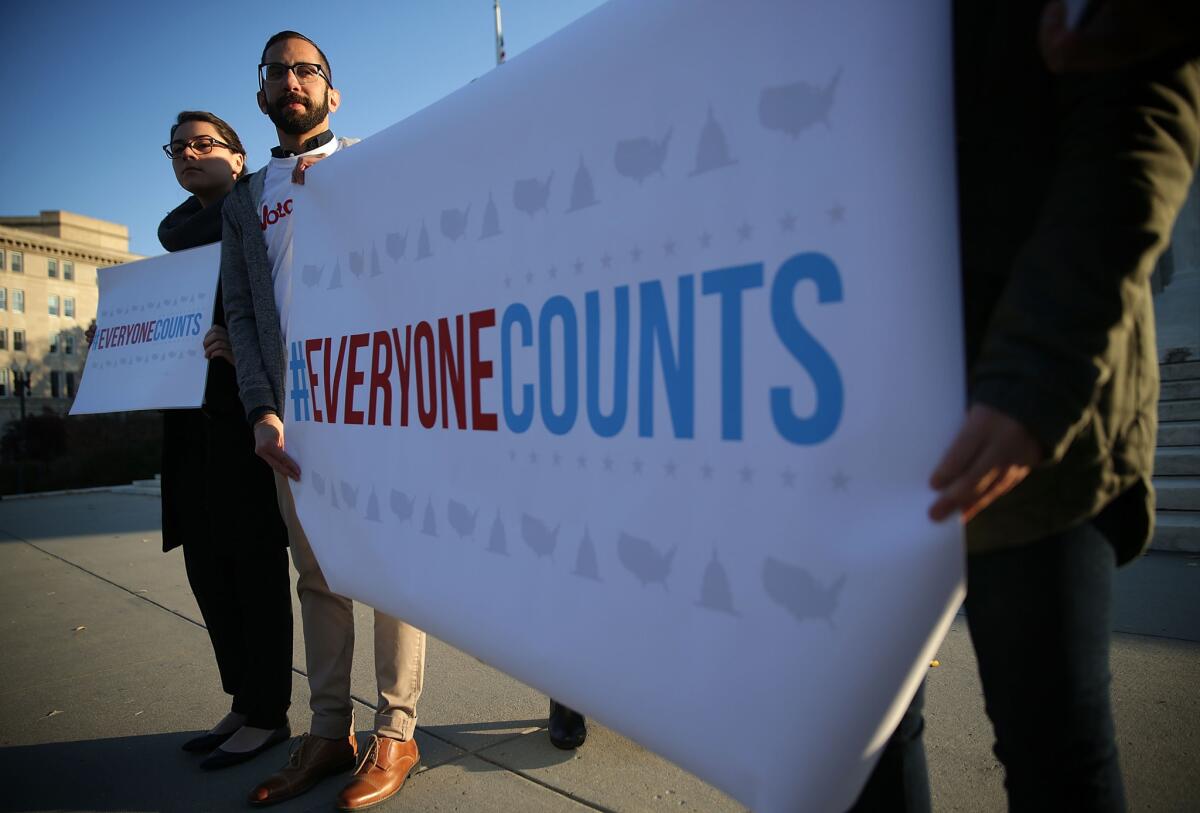Editorial: ‘One person, one vote’ is simply the best system

Activists hold signs during a news conference in front of the Supreme Court on Dec. 8, the day the court hears oral arguments on Evenwel v. Abbott.
- Share via
On Tuesday a lawyer for two Texas residents asked the Supreme Court to rule that the Constitution’s guarantee of “one person, one vote” in the drawing of state legislative districts actually means “one eligible voter, one vote” — a holding that would end the usual practice of basing representation on total population, including children and noncitizens. It’s an ingenious argument, but the court should reject it.
A decision in favor of the plaintiffs would introduce massive uncertainty into redistricting for state legislatures. Equally ominous, it would disadvantage areas, such as Southern California, where many residents are not yet citizens or voters but still use the roads, schools and other public services.
The plaintiffs in Evenwel vs. Abbott, supported by a conservative organization known as the Project on Fair Representation, claim to have precedent on their side, notably a 1964 ruling in which the court held that malapportioned districts unconstitutionally “diluted” the votes of some citizens in relation to those of others. Because there were far fewer noncitizens then, it made little difference whether lines were drawn on the basis of total population or on some other factor. But today, in many places, large numbers of noncitizens mean that districts of roughly equal population can have dramatically different percentages of eligible voters.
If [California] were required to draw lines to reflect only eligible voters, power would shift away from areas heavily populated by noncitizens, many of them Latino.
That’s the case not only in Texas but also in California. If this state were required to draw lines to reflect only eligible voters, power would shift away from areas heavily populated by noncitizens, many of them Latino. Some districts would expand as a result, making it harder for state legislators to address individual constituents’ problems and for residents to sway those legislators.
That gets to the biggest flaw in the plaintiffs’ argument: that elected officials serve only those who can vote. As the U.S. 9th Circuit Court of Appeals held in a 1990 case involving apportionment of the L.A. County Board of Supervisors: “The purpose of redistricting is not only to protect the voting power of citizens; a coequal goal is to ensure equal representation for equal numbers of people.” Justice Sonia Sotomayor made the same point at Tuesday’s argument: “There is a voting interest,” she said, “but there is also a representational interest.”
Ideally the millions of noncitizens living in this country — legally and illegally — would obtain U.S. citizenship and along with it the right to vote. Democracy functions best when those who are affected by government policies can shape those policies at the ballot box. But in the meantime, they rely on — and finance with the sales taxes and other levies that noncitizens pay — public services and many of their children attend public schools. They are entitled to effective representation even if they cannot vote.
There is a final powerful argument for counting all residents. The Constitution requires that the apportionment of seats in the U.S. House of Representatives be based on “the whole number of persons in each state.” That requirement is contained in the 14th Amendment, which also says that states may not “deny to any person within its jurisdiction” — person, not citizen — “the equal protection of the laws.”
As Deputy Solicitor Gen. Ian H. Gershengorn told the justices, “It would be a very odd interpretation to say that the Constitution forbids for state legislative redistricting what it requires for congressional redistricting.” In this case, the simplest system is also the fairest.
Follow the Opinion section on Twitter @latimesopinion and Facebook
More to Read
A cure for the common opinion
Get thought-provoking perspectives with our weekly newsletter.
You may occasionally receive promotional content from the Los Angeles Times.






